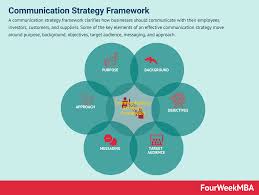Mastering Effective Communication Strategies for Business Success
The Power of Effective Communication Strategies
In today’s fast-paced and interconnected world, communication plays a crucial role in the success of any business or organisation. Having a well-defined communication strategy is key to effectively conveying your message, building relationships with stakeholders, and achieving your goals.
Effective communication strategies are not just about what you say but also how you say it. They involve careful planning, clear objectives, and consistent messaging across various channels. By developing a robust communication strategy, businesses can enhance their brand reputation, engage with their target audience, and drive desired outcomes.
Key Elements of a Successful Communication Strategy:
- Clear Objectives: Define specific goals that you want to achieve through your communication efforts. Whether it’s increasing brand awareness, generating leads, or managing a crisis, having clear objectives will guide your strategy.
- Target Audience Analysis: Understand who your target audience is, their preferences, behaviours, and communication channels they use. Tailor your messages to resonate with your audience effectively.
- Consistent Messaging: Ensure that your messaging is consistent across all platforms – from social media and PR to internal communications. Consistency helps in building brand identity and credibility.
- Multichannel Approach: Utilise a mix of communication channels such as social media, email marketing, press releases, events, etc., to reach a wider audience and maximise impact.
- Evaluation and Adaptation: Regularly monitor the performance of your communication efforts against set KPIs. Analyse the results and be prepared to adapt your strategy based on feedback and insights gained.
By implementing these key elements into their communication strategies, businesses can create compelling narratives that resonate with their audience and drive engagement. Effective communication strategies not only help in conveying messages but also in building trust, fostering relationships, and ultimately achieving business success.
In conclusion, investing time and resources into developing a well-thought-out communication strategy is essential for any business looking to thrive in today’s competitive landscape. By crafting messages that are relevant, authentic and impactful businesses can establish themselves as industry leaders and connect meaningfully with their stakeholders.
Essential FAQs on Crafting and Optimising Effective Communication Strategies for Businesses
- What is a communication strategy and why is it important?
- How can businesses develop an effective communication strategy?
- What are the key components of a successful communication strategy?
- How can companies measure the success of their communication strategies?
- Why is it necessary for organisations to adapt their communication strategies to changing trends?
What is a communication strategy and why is it important?
A communication strategy is a comprehensive plan that outlines how an organisation will communicate its messages to its target audience effectively. It involves defining clear objectives, identifying key messages, selecting appropriate communication channels, and establishing a consistent tone and style. A well-crafted communication strategy is crucial for businesses as it helps in conveying the right message to the right audience at the right time. By having a structured approach to communication, organisations can build brand awareness, enhance their reputation, engage with stakeholders, and achieve their overall business goals. In essence, a communication strategy serves as a roadmap that guides businesses in creating meaningful connections with their audience and driving success in a competitive market environment.
How can businesses develop an effective communication strategy?
Developing an effective communication strategy is vital for businesses seeking to enhance their brand presence and engage with their target audience successfully. To create a robust communication strategy, businesses should start by setting clear objectives aligned with their overall goals. Conducting thorough research to understand the target audience, their preferences, and communication channels is crucial. Crafting consistent and compelling messaging that resonates with the audience across various platforms is key. Utilising a mix of communication channels and regularly evaluating the strategy’s performance to make necessary adjustments based on feedback and insights are essential steps in developing an effective communication strategy for businesses.
What are the key components of a successful communication strategy?
When discussing the key components of a successful communication strategy, it is essential to highlight several crucial elements that contribute to its effectiveness. Clear objectives play a pivotal role in guiding the direction of the strategy, ensuring that communication efforts are aligned with specific goals. Understanding the target audience and tailoring messages to resonate with them is another critical component. Consistency in messaging across various channels helps in building brand identity and credibility. Employing a multichannel approach to reach a wider audience and evaluating performance metrics for continuous improvement are also integral parts of a successful communication strategy. By incorporating these key components, businesses can create impactful communication strategies that engage audiences and drive desired outcomes.
How can companies measure the success of their communication strategies?
Measuring the success of communication strategies is essential for companies to gauge the effectiveness of their efforts and make informed decisions for future initiatives. Companies can evaluate the impact of their communication strategies through various metrics such as brand awareness, audience engagement, website traffic, social media interactions, media coverage, customer feedback, and ultimately, the achievement of predefined communication goals. By analysing these key performance indicators (KPIs) and comparing them against set targets, companies can gain valuable insights into the effectiveness of their communication strategies and make necessary adjustments to enhance their overall impact and achieve greater success in their communications efforts.
Why is it necessary for organisations to adapt their communication strategies to changing trends?
Adapting communication strategies to changing trends is essential for organisations to stay relevant and competitive in today’s dynamic business environment. As trends evolve, so do consumer preferences, technological advancements, and communication channels. By adjusting their strategies accordingly, organisations can ensure that they effectively reach their target audience, engage with them in meaningful ways, and stay ahead of the curve. Failing to adapt to changing trends may result in missed opportunities, loss of market share, and diminished brand visibility. Therefore, organisations must be proactive in monitoring trends and adjusting their communication strategies to remain agile and responsive to the ever-changing landscape of the industry.




